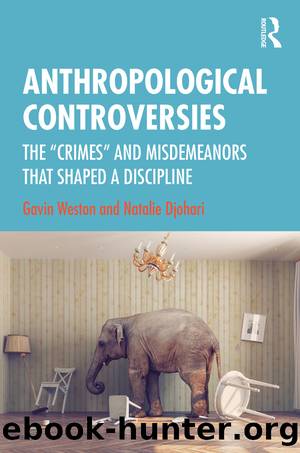Anthropological Controversies by Weston Gavin; Djohari Natalie;

Author:Weston, Gavin; Djohari, Natalie;
Language: eng
Format: epub
Publisher: Taylor & Francis Group
Published: 2020-08-15T00:00:00+00:00
6Mead versus Freeman
Background
Margaret Mead is a strong contender for the most influential anthropologist in the history of social and cultural anthropology. Mead was born in 1901 and died in 1978. During her time she achieved face-on-a-stamp fame, regularly appearing on television talk shows in an era with limited channels and huge audiences (Lutkehaus 2008). Her ideas on gender relations, cultural relativism, and sexual behavior and her critiques of American repression regarding the body, birth, death, and race permeated public consciousness and influenced political and societal changes. Her hand can be seen in 1960s countercultural ideas regarding love, sex, and marriage; through the work she did as part of the US war effort in World War II within the National Character Studies project; and in the subtle influencing of her daughter’s pediatrician, Benjamin Spock, whose child care manual educated a generation of new parents on breastfeeding. The influence Mead had was as much a testimony to her character as it was to her work. YouTube has a myriad of snippets of interviews, conversations, and talks with Margaret Mead. Watching them, you are struck by her clarity of speech and the ease with which she conveys big ideas as obvious. This accessibility was also present in her writing, with Coming of Age in Samoa (1928) achieving mainstream success, having sold over a million copies by the time of her death (Shankman 2009: 101). Mead conveyed anthropological ideas in a way that seems wise rather than preachy, with ideas about differences and similarities, and how people might live better, coming across as humane rather than intellectual grandstanding. She was forthright in a way that might seem rude were she not so charismatic.
While her life was not without its own controversies (see previous chapter on Project Camelot) or scholarly disagreements, she was widely renowned and largely beloved within anthropology. But in 1983, Derek Freeman, an Australian anthropologist who covered the same research terrain as Mead decades later, published a book that tarnished her reputation. Today, after more than 30 years of debate provoked by Freeman’s book, within anthropology the pendulum seems to be swinging back in favor of Mead, but there have been decades where the veracity of Mead’s research was called into question. At the heart of this critique lies Freeman’s contention that, as a young and inexperienced researcher, Mead was hoaxed by the young women who were central to her research. But before we return to this “fateful hoaxing” (Freeman 1999), we first need to delve into the research that forms the basis of this argument and Mead’s place in anthropology. The controversy that temporarily stalled Mead’s popularity had a very slow-burning fuse. It begins with Mead’s first foray into fieldwork in Samoa in 1925 and is concerned with her most famous book, Coming of Age in Samoa (1928). While the book was renowned from the start, the social life of the book radically shifts as it is adopted by the countercultural movement of the 1960s as a manifesto for free love and as a critique of the repressed nature of the United States.
Download
This site does not store any files on its server. We only index and link to content provided by other sites. Please contact the content providers to delete copyright contents if any and email us, we'll remove relevant links or contents immediately.
| Anthropology | Archaeology |
| Philosophy | Politics & Government |
| Social Sciences | Sociology |
| Women's Studies |
Born to Run: by Christopher McDougall(6884)
The Leavers by Lisa Ko(6790)
iGen by Jean M. Twenge(5141)
Sapiens by Yuval Noah Harari(5101)
The Kite Runner by Khaled Hosseini(4937)
Spare by Prince Harry The Duke of Sussex(4762)
Bullshit Jobs by David Graeber(3805)
Livewired by David Eagleman(3522)
Machine Learning at Scale with H2O by Gregory Keys | David Whiting(3518)
Never by Ken Follett(3500)
Goodbye Paradise(3426)
Fairy Tale by Stephen King(2898)
A Dictionary of Sociology by Unknown(2838)
Harry Potter 4 - Harry Potter and The Goblet of Fire by J.K.Rowling(2786)
The Social Psychology of Inequality by Unknown(2745)
The Club by A.L. Brooks(2737)
People of the Earth: An Introduction to World Prehistory by Dr. Brian Fagan & Nadia Durrani(2609)
0041152001443424520 .pdf by Unknown(2578)
Will by Will Smith(2555)
